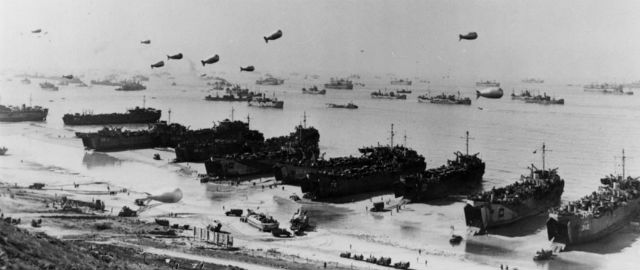The longest day in history which changed the world…
by Paolo Piu
France for reasons of state, between 5th and 6th June will mark the 75th anniversary of the Normandy landings. On that famous day called D-Day (according to some to be interpreted as Decision Day, for others simply a meaningless code name), within the military operation Overlord, the great military feat of the world war was carried out, which hastened its conclusion and freed Europe from Nazism. This military feat was organized by the US and British armies with the collaboration of other countries, including Canada, France and other European states invaded by Nazi Germany.
US General Dwight Eisenhower was in supreme command of the operation; British General Bernard Montgomery commanded the ground forces. The landing strategy was studied in detail. First of all, it had to take place during the full moon phase, necessary not only to illuminate the darkness during navigation, but also because it regulates the flow of the tides, so as to be able to avoid the mines positioned in the sea and get as close as possible to the beaches with landing craft. They chose June 5th but then they moved it to June 6th because of bad weather conditions. It was set up the largest landing fleet in history in order to successfully implement the operation. This fleet numbered over 5.000 ships of all kinds. Hundreds of thousands of men were employed, tens of thousands of tanks and military vehicles. Nothing like this had ever been seen in the world before.
The German General Erwin Rommel was given the task of reinforce the Atlantic Wall, which stretched from Norway to the border of Spain. It was him who gave the definition that became famous («…the first 24 hours of the invasion will be decisive…for the Allies and for Germany will be the longest day»). He also predicted that the landing site would have been Normandy, going against the widespread opinion between Hitler and the other officers of the German High Command, who were convinced that the Allies would have landed in Pas-de-Calais. This was the place where the Americans originally wanted to land, but was also the point where the Germans had most strengthened their defences because they expected a military action. Several mock landing operations by the Allies at Calais reinforced this belief. The British, on the other hand, identified Normandy as the most strategically suitable place. In the end the decision was made, opting for the five beaches which are along the 50 miles of the Norman Coast.
The day the landing took place, Rommel was in Germany to celebrate his wife’s birthday, reassured by the fact that there would be no danger given the bad weather conditions. Nothing suggested that that very day would have been chosen for the great operation, which remained secret until the last moment. That memorable date caught Germany completely unprepared to face the opposing forces, but once again Hitler gave the order not to move the bulk of the troops, thinking it was a distracting manoeuvre and that the actual landing site would be Calais.
The codenames give to the beaches were: Utah and Omaha, assigned to the Americans, Juno and Sword, to the British and Canadians. The Allies who landed on these beaches starting from the 6th of June were a total of two million and eight hundred thousand, of which more than half were Americans; the others were mainly British, Canadians and French, but there was also the participation of Australians, Belgians, Norwegians and Dutch.
In Sword beach, the one further east, parachutists were thrown in the middle of the night, but due to the dark and the strong wind they land far from the objective. However, they succeeded to gather and conquer the beach before the arrive of the allied infantry. The Anglo-Canadians landed on Juno. That was the second beach registering the highest victims’ amount: 1200 between dead and injured.
Even at Utah the 82nd and the 101st airlifted U.S. divisions, composed by 13 thousand parachutists, were unlucky on landing, that’s because this tactic was not used for the rest of the war. As a result, 45% of the units was scattered in a vast territory and because of that could not reunite. Anyway, when in the morning the troops landed on the beach by sea, this beach was already conquered. 82nd Division’s parachutists occupy Sainte-Mère-Eglise, which was the first French city freed by the Allied troops before the dawn.
On the 6-km-beach of Omaha instead everything went wrong immediately, in fact, this beach was the best protected one. Here the first soldiers landed to far away from the shore and died drowned because of the heavy equipment. The German defence of the 352nd Division turned the machine-gun around in direction to the landing crafts and lots of American soldiers died before setting foot on land. The commanding officers even thought to go back and give up the landing operation. Furthermore, the Allied aircraft bombed behind the defence line but not above the objectives and the beach because of the scarce visibility, so when the troops landed, didn’t find a dip where repair themselves from the enemy fire. After 10 minutes from the first wave of landing, in certain sectors the soldiers were completely in disarray, because all the officers and non-commissioned officers were dead or wounded. This happened because, unlike the other beaches, the troops were not supported by the Shermans, the amphibious tanks created for the occasion, which due to the strong wind and current landed several kilometers away or sank into the sea. The victims among the Americans were from 3 to 5 thousand out of a contingent of almost 50 thousand men.
We should not forget the role played by the Rangers of the 2nd and 5th Battalions, who managed to climb the cliffs of Pointe du Hoc, 30 to 100 meters high, with ladders and ropes, under incessant enemy fire. The cliffs were located at the two ends of Omaha beach, and the aim was to destroy the enemy artillery pieces placed on top. When the Rangers finally managed to reach the goal, they realized that the feared guns were not there. The feat cost losses over 70% of the quota. Photographer Robert Kapa was an exceptional witness to these events. We owe him most of the photos depicting the landing right on Omaha beach.
Eventually Normandy was reconquered and from there began the liberation of Europe. But the number of victims on those beaches was very high: 10-12 thousand among the Allies, between 4 and 9 thousand among the Germans. Rommel committed suicide that same year, while in 1953 Eisenhower was elected 34th President of the United States.
After the success achieved thanks to this operation that accelerated the end of the war, the Americans reached the apex of popularity in the international arena, which they never managed to match in the following decades.
Some films have evoked this story. Among the most important are: The longest Day (1962), based on the book of the same name by Cornelius Ryan and Saving Private Ryan (1998), directed by Steven Spielberg, both winners of the Oscar award.
It is important to keep in mind that if we ignore the events that happened in the past, they are bound to repeat themselves. On this date we want to commemorate and honor the thousands of victims among the Allies who, had they not succeeded in their feat, Europe would have remained under the Nazi dictatorship for a long time and the world would have been very different from what we know today.

